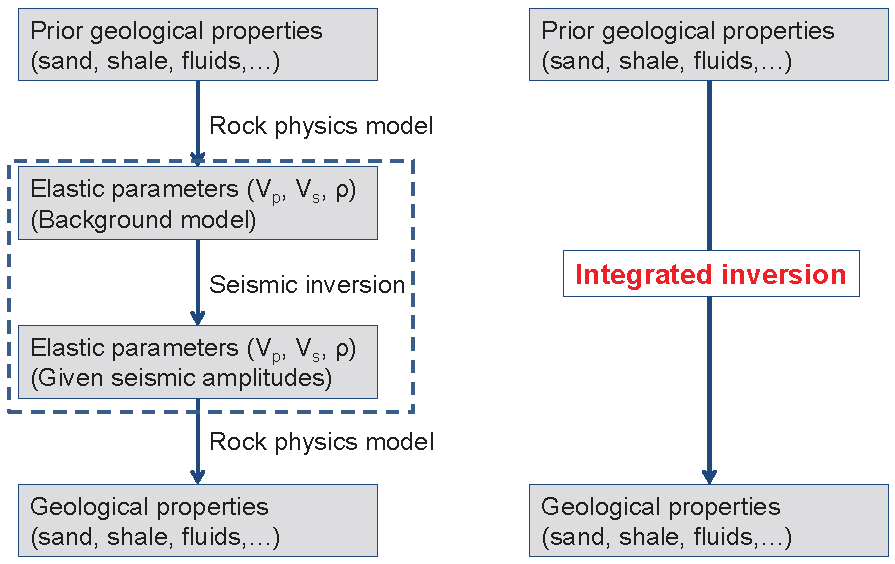The GIG Consortium - Geophysical Inversion to Geology
The GIG Consortium - Geophysical Inversion to Geology
The GIG Consortium is hosted by the Norwegian Computing Center.
The GIG Consortium will develop new understanding, new methods and software for obtaining reservoir properties from geophysical measurements such as seismic surveys. Important reservoir properties are zonation, lithology and fluid classes, and petrophysical properties such as porosity and saturations. Methods will be based on established geophysical understanding and empirical rock physics relationships. The connection between reservoir properties and geophysical measurements is non-unique so developed inversion methods will utilize probabilistic models to quantify uncertainty and risk. Developed methods can be used for hydrocarbon exploration and field development.
Invitation
The GIG Consortium is open to oil and gas companies. There is a yearly fee and an initial enrolment fee. New consortium sponsors get immediate access to the software PCube and PCube+ and other consortium results.
Sponsor benefits:
-
Early access to research results and new methods
- Reports (only available to sponsors)
- Software prototypes
-
Immediate access to PCube+ and PCube executable and source code
- Immediate access to updates, maintenance and support
-
Influence on priorities
- Direct influence on the Working Plan by voting for your favorite research and development tasks
- Access to bi-weekly meetings with presentations and discussions
Better Geophysical Inversion
Geophysical inversion is a non-unique ill-posed inversion problem; many geometric configurations of geological properties can give identical measurement response and the resolution of the measurements makes it impossible to observe all relevant details. Unguided inversion is therefore impossible and some kind of regularization must be used. A cornerstone in all inversion techniques that will be investigated by the GIG Consortium is that the regularization is determined by geological constraints: gas is on top of oil, oil is on top of brine, the stratigraphy follows certain rules, et cetera. This will dramatically limit the search for the correct inversion result and give higher accuracy. The PCube+ software demonstrates this very clearly.
Traditional geophysical inversion focuses on the parameters that can be measured. For seismic inversion these are the elastic parmeters (Vp, Vs, ρ) and for EM inversion this is resistivity. Relevant geological properties such as lithofacies and fluid fractions are related to these parameters by rock physics relationships. The standard seismic inversion approach is to focus on elastic parameters and occasionally relate the background model to geological properties. Since geological properties are the main interest, the inverted elastic parameters are often transformed into geological properties using, again, rock physics relationships. We believe this can be done simpler and better. By focusing on geological parameters we can propagate the geological constraints consistently from the prior model to the final inversion result. This is illustrated here:

The scheme on the left is the traditional approach whereas the GIG Consortium will follow the Integrated inversion scheme to the right. Rock physics relationships are an important part of the Integrated inversion scheme but they are not separated from the seismic inversion process, the geological properties and the elastic parameters always exist side-by-side. The Integrated inversion scheme bypasses the stepwise approach and this has many advantages:
- It is simpler
- It is more accurate
- It propagates the uncertainty and ambiguity in each step
- Uncertainty in the rock physics relationships is handled properly
- Geological constraints are honored all the way and not forgotten in the intermediate steps
- It focuses on the end product, the geological properties relevant for exploration and production of hydrocarbons
- Geophysical parameters such as Vp, Vs and ρ are by-products and can easily be generated for QC
We have great expectations for this approach and have already proven that it works for elastic inversion. In the future we plan to improve the technology, expand it to new survey types, document its advantages and limitations, and make userfriendly versatile tools for the GIG Consortium partners.
Knowledge background
The GIG Consortium was formally started in March 2016. However, the Norwegian Computing Center and personnel at the partners have been deeply involved in developing methods and software for geophysical inversion for many years.
The GIG Consortium builds directly on the PCube software that has been implemented by the Norwegian Computing Center and Statoil ASA. PCube is a seismic inversion software that computes lithology and fluid probabilities from seismic AVO data. The PCUBE source code will be used as a platform for further development. The current version has a GUI on Windows. An invention by Norwegian Computing Center and Statoil is used by the PCube+ software. The invention is protected by Patent GB2463242 (Kolbjørnsen, O., R. Hauge and A. Buland 2012) held by Statoil. The source code repository for the PCube software and any use of this is to be considered as initial Consortium Results together with the rights to use this invention.
The Consortium will also benefit from the experience at Norwegian Computing Center from a range of projects involving geophysical data. The most prominent besides PCube is the development of the elastic inversion software called CRAVA based on Buland, Kolbjørnsen and Omre (2003). See also Ng, Dahle, Hauge and Kolbjørnsen (2008) for an application of CRAVA.
Norwegian Computing Center has developed and published various techniques for seismic inversion including Kjønsberg et al. (2010) and Hammer et al. (2012). Other relevant studies that Norwegian Computing Center has been involved in are inversion of CSEM (Kolbjørnsen et al. 2008 and 2012) and gravimetric data (Hauge and Kolbjørnsen 2015).
The use of geological knowledge to constraint the inversion results is a key element to obtain robust and fast results. Norwegian Computing Center has a long history of making stochastic models for geological surfaces, faults, depositional geometries and petrophysical properties. Background information can be found on Petroleum reservoir models (depositional geometries and petrophysics), COHIBA (surfaces), and HAVANA (faults).
The Uncertain Reservoir Evaluation (URE) initiative at NTNU is working with similar problems, and we follow their work closely. Both CRAVA and PCube are built on extensions of the theoretical framework developed there (Buland, Kolbjørnsen and Omre 2003 and Buland and Omre 2003). More recently, Rimstad, Avseth and Omre (2012) introduce theory that might be considered for inclusion in PCube, in particular depth trends for rock physics (already present in CRAVA) and wavelet uncertainty.
Publications
Kolbjørnsen, O., Buland, A., Hauge, R., Røe, P., Ndingwan, A.O., Aker, E., 2020, Bayesian seismic inversion for stratigraphic horizon, lithology, and fluid prediction. Geophysics, v. 85(3), p. R207-R221. http://dx.doi.org/10.1190/GEO2019-0170.1
Kolbjørnsen, O., Buland, A., Hauge, R., Røe, P., Jullum, M., Metcalfe, R.W. and Skjæveland, Ø., 2016, Bayesian AVO inversion to rock properties using a local neighborhood in a spatial prior model. The Leading Edge, v. 35(5) p. 431-436. http;//dx.doi.org/10.1190/tle35050431.1
Kolbjørnsen, O., R. Hauge and A. Buland, 2012, Method for modelling a subterranean region of the earth, UK Patent GB2463242 held by Statoil.
Riise, O., Elgenes, J., Frey-Martinez, J.M., Kjøsnes, Ø and Buland, A., 2012, Detailed Lithology and Fluid Mapping of the Asterix Gas Discovery Using Bayesian Inversion Methodology: Proc. EAGE 2012, http://www.earthdoc.org/publication/publicationdetails/?publication=58952
Kjønsberg, H., R. Hauge, O. Kolbjørnsen and A. Buland, 2010, Bayesian Monte Carlo method for seismic predrill prospect assessment. Geophysics, v. 75(2), p. O9-O19, http://dx.doi.org/10.1190/1.3339678
Buland, A., Kolbjørnsen, O. Hauge, R., Skjæveland, Ø. and Duffaut, K, 2008, Bayesian lithology and fluid prediction from seismic prestack data. Geophysics, v. 73(3) p. C13-C21, http://dx.doi.org/10.1190/1.2842150
Kolbjørnsen O., Almendral Vazquez A., and Buland A., 2008, Bayesian common midpoint inversion for controlled source electromagnetics, NR-note, SAND/12/08, Norwegian Computing Center
Presentations
Kjønsberg, Heidi; Haug, Sissel Grude; Hauge, Ragnar; Nilsen, Carl-Inge Colombo. Time lapse AVO inversion for the Heidrun field in the Norwegian Sea. Konferanse, SEG20; Houston (virtuelt), 11.10.2020 - 15.10.2020.
Aker, E., Kjønsberg, H., Røe, P. and Kjøsnes, Ø., 2018, Probabilistic inversion into lithology and fluid classes in the North Sea – Comparison of one- and two-step approach, EAGE Annual, 80th Conference and Exhibition, Copenhagen, Denmark, 11.06.2018
Røe, P., Kolbjørnsen, O. and Hauge, R., 2017, Comparison of one- and two-step seismic inversion for lithology and fluid prediction, Presentation at FORCE Seminar, Practical Rock Physics and Inversion for Exploration and Production, 17.10.2017
Skjæveland, Ø.M. and Srivastava R.P., 2017, Pcube+ inversion - connecting rock physics and seismic amplitudes (updated), Presentation at FORCE Seminar, Practical Rock Physics and Inversion for Exploration and Production, 17.10.2017
Aker, E., Røe, P., Kjøsnes, Ø., Hauge, R., Dahle, P., Ahmadi, G.R. and Sandstad, O.A., 2017, Probabilistic prediction of lithology-fluid-classes from seismic - A North Sea case study, Presentation at 4th International Workshop on Rock Physics, Trondheim, 01.06.2017
Røe, P. et.al., 2016, The GIG Consortium, Presentation for FORCE Improved Exploration Network Group, Stavanger, 17.11.2016
Skjæveland, Ø.M., 2016, PCube+ - Additional slides to the presentation held at the NPF Biennal Geophysical Seminar (see below), Presentation for FORCE Improved Exploration Network Group, Stavanger, 17.11.2016
Skjæveland, Ø.M., Metcalfe R.W., Kolbjørnsen O., Røe P. and Hauge R., 2016, Pcube+ - high-resolution horizon update by prestack inversion, The Biennial Geophysical Seminar, Kristiansand, 14.03.2016 - 16.03.2016.
References
Buland, A., and H. Omre, 2003, Bayesian linearized AVO inversion. Geophysics, 68, 185-198, http://dx.doi.org/10.1190/1.1543206
Buland A, Kolbjørnsen O and Omre H, 2003, Rapid spatially coupled AVO inversion in the Fourier domain. Geophysics, v. 68(3) p. 824-836, http://dx.doi.org/10.1190/1.1581035
Hammer, H., O. Kolbjørnsen, H. Tjelmeland and A. Buland, 2012, Lithology and fluid prediction from prestack seismic data using a Bayesian model with Markov process prior: Geophysical Prospecting, v. 60(3), p. 500-515, http://dx.doi.org/10.1111/j.1365-2478.2011.01012.x
Hauge V.L. and Kolbjørnsen O., 2015, Bayesian inversion of gravimetric data and assessment of CO2 dissolution in the Utsira Formation. Interpretation, 3(2), SP1-SP10, http://dx.doi.org/10.1190/INT-2014-0193.1
Kolbjørnsen, O., Hauge, R.; Drange-Espeland, M., Buland, A. 2012, Model-based fluid factor for controlled source electromagnetic data. Geophysics, v. 77(1) p. E21-E31, http://dx.doi.org/10.1190/geo2010-0300.1
Ng, S., Dahle P., Hauge R. and Kolbjørnsen O., 2008, Estimation of facies probabilities on the Snorre field using AVA inversion. SEG, 78th annual meeting, Las Vegas.
Rimstad, K., P. Avseth and H. Omre, 2012, Hierarchical Bayesian lithology/fluid prediction: A North Sea case study. Geophysics, v. 77(2), p. B69-B85, http://dx.doi.org/10.1190/geo2011-0202.1

Links
Partners
Current sponsors:
Commercial software development:




 How to get to NR
How to get to NR Share on social media
Share on social media Privacy policy
Privacy policy